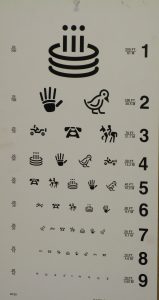According to the American Optometric Association (AOA) children should have their eyes examined by an eye doctor at 6 months, 3 years, and at the start of school. This especially true if the child has certain risk factors (such as developmental delays, premature birth, crossed or lazy eyes, family history or previous injuries). If there are any signs or symptoms that there may be a vision problem, more frequent exams are recommended. A child who wears eyeglasses or contact lenses should have his or her eyes examined yearly.
Besides evaluating for nearsightedness, farsightedness and astigmatism (refractive errors), your eye doctor will exam the internal and external area of the eye, checking for any eye health related conditions. Because vision problems are commonly associated with learning difficulties, it is important that your child be examined by a vision care specialist. A pediatric vision screening does not qualify as an adequate vision exam.
A Developmental Optometrist is most qualified to screen for the following pediatric vision issues:
• Amblyopia: Also known as a “lazy eye,” there is decreased vision in one or both eyes despite the absence of any eye health problem or damage. Common causes of amblyopia include strabismus and a significant difference in the refractive errors of the two eyes. Treatment of amblyopia may include patching the dominant eye to strengthen the weaker eye.
• Strabismus: This is misalignment of the eyes, often caused by a congenital defect in the positioning of the muscles. When untreated, strabismus can cause an amblyopic eye. Most commonly, there may be symptoms of double vision, headaches and eyestrain and reduced depth perception. Treatment plans may include Optometric Vision therapy and/or surgery.
• Convergence insufficiency: This is the inability to keep the eye comfortably aligned for reading and other near tasks. Convergence insufficiency can be successfully treated with Optometric Vision Therapy and/or special reading lenses.
• Focusing problems: Children with focusing problems (also known as accommodation) may have trouble changing focus from distance to near and back again or simply have blurry vision or eye fatigue when reading.
Eye Exams in Infants: Birth – 24 Months
A baby’s visual system develops gradually over the first few months of life. They have to learn to focus and move their eyes, and use them together as a team. The infant brain also needs to learn how to process the visual information from the eyes in order to understand and interact with the world. The foundation for motor development such as crawling, walking and hand-eye coordination also comes with the development of eyesight. Since there is a higher risk of eye and vision problems if your infant was born premature or is showing signs of developmental delay, your eye doctor may require more frequent visits to keep watch on his or her progress.
Eye Exams in Preschool Children: 2-5
The toddler and preschool age is a period when children experience drastic growth in intellectual and motor skills. During this time, they will begin developing their fine motor skills, hand-eye coordination and visual perceptual abilities. Adequate visual skills provide the basis for learning to read and write, play sports and participate in creative activities such as drawing, sculpting or building.
Eye Exams in School-Aged Children: Ages 6-18
Undetected or uncorrected vision problems can cause children and teens to suffer academically, socially, athletically and personally. Proper learning, motor skills development and reading comprehension are dependent upon good eyesight good visual-motor skills. Children with undetected vision problems will often experience frustration, and exhibit behavioral problems as well. Often, they don’t know that the vision they are experiencing is abnormal, so they aren’t able to express that they need help. This is the age where vision problems are misdiagnosed and mislabeled as ADD or dyslexia.
Signs or symptoms of vision problems in children include:
- Short attention span
- Headaches
- Frequent blinking
- Avoiding reading
- Tilting the head to one side
- Losing their place often while reading
- Double vision
- Poor reading comprehension

